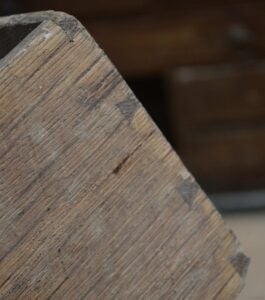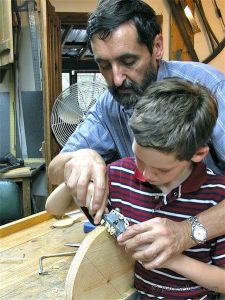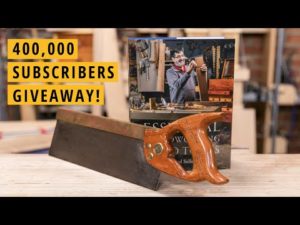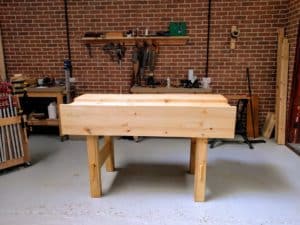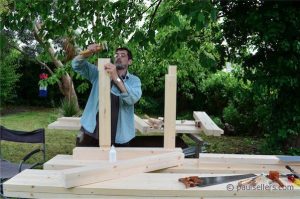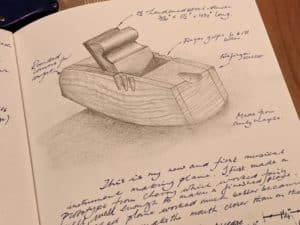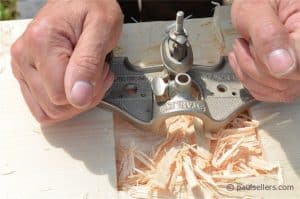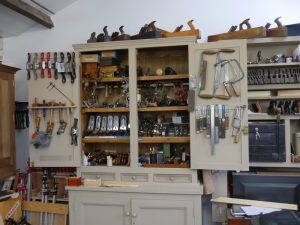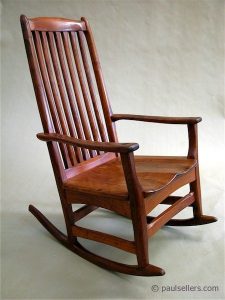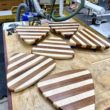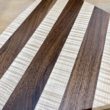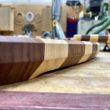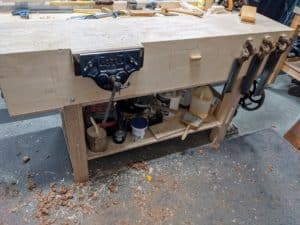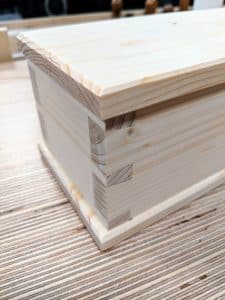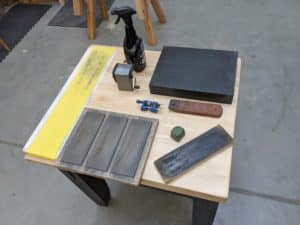Panel glueups seem easy but a lot of folks are in for a rude awakening when the panel doesn’t stay flat. Here are 10 tips and tricks that should help stack the cards in your favor for a nice flat glueup.
1. Use stable, dry wood.
Inspect your boards for cups or twists and try to find boards that are already mostly flat. A heavily-twisted board can be milled flat, but there’s a good chance it will return to that warped state so it’s not a good candidate for a panel. Also, be sure the wood is dry and well-acclimated to your shop environment. I like to make sure my boards are in my shop for a few weeks before incorporating them into a panel.
2. Consider the grain.
Great looking panels don’t happen accidentally. Make your grain arrangement purposeful. Most times I try to orient the grain so it gives the illusion of a single panel. On my executive desk I took it a step further by intentionally butting up sapwood to sapwood so that the joint became harder to see. Sometimes I’ll also create a bookmatch pattern, such as with crotch wood, to make the joint part of the design.
3. Mill the boards evenly.
When milling your boards, make an effort to count the number of passes so that you remove the same amount of material from each face. This should help keep the board balanced as it acclimates to the environment. Wood is a lot like a sponge. It readily absorbs moisture. And as it dries, there’s more moisture deep inside than there is at the surface. As long as it picks up and loses moisture evenly, it stays relatively flat. But if we take too many passes on one face of a board, it knocks it out of equilibrium and the board will cup. Any time we have more moisture on one side than the other, there’s a potential for cupping.
4. Ensure 90 degree edges.
Don’t just look at the fence of your jointer. Look at the wood itself after jointing. Many jointer fences aren’t perfect so it’s the result of the cut that really matters. Your fence doesn’t actually need to be at a perfect 90 if you joint your boards in such a way that it negates the angle. When you unfold them, they will offset each other.
5. Use alignment aids to help keep your boards flush.
With glue in the joint, the boards will slip and slide around and it can be hard to keep the boards flush, especially on larger glue-ups. If you use biscuits, dowels, dominos, or even a splines and tongue and groove joints, you can make your life a LOT easier as the boards will stay nice and flush during the glueup. On smaller panels, you can actually just use a clamp at each joint to keep the panels flush. On larger panels you might also consider using cauls. These are simple strips of wood that are coated in wax or packing tape to prevent the glue from sticking. They sandwich the glueup making sure everything stays flat. You also might want to look into cambered caul, where there’s a slight hill in the middle. The advantage here is that just by clamping the outsides of the cauls, you’ll have a great deal of pressure at the center too, which is very effective on big glueups where you can’t get clamping pressure in the center of the panel.
6. Use a glue that matches the color of the wood.
Glue comes in a lot of different colors and if you use one that’s close to the color of your lumber, you can further help disguise the joint. And did you know you can add dye to glue to get custom colors? Sometime I add Transtint dyes to get a unique color.
7. Clamp properly.
First, make sure you use enough clamps. A good rule of thumb is to space the clamps on the 45’s. If you imagine the clamping pressure spreading out at a 45 degree angle in both directions, you simply make sure there are no uncovered areas. Narrow boards require more clamps and wider boards require fewer clamps.Because clamps can sometimes put uneven pressure on joints, I like to alternate my clamp orientation too.
When applying pressure, especially when you don’t have alignment aids, start with a small amount of pressure at each clamp. This allows the glue to squeeze out and gives the boards a chance to get grippy while still staying flat. Clamp too fast on any one clamp and the pieces will just slide around.
8. Scrape the excess glue.
If you let the glue dry on the surface and then try to scrape it away, the glue drops can take some wood with them. So I like to give my panels at least 30 minutes to set up before scraping away the glue. At this point, the glue is still flexible and comes off easily with a putty knife without tearing out wood or spreading glue all over the place. Be sure to remove the glue from between the clamp bar and the wood to help prevent staining.
9. Let panels rest on end, not on a face.
Inevitably you’ll need to leave your panels overnight and this is where the surprises can sometimes happen. I like to let my panels breathe so I prop them up slightly or rest them on their side. This helps provide even air flow on all sides of the panel and promotes flatness. If for some reason you need to leave the panels for an extended period of time, consider stretch wrapping. The plastic will slow down the penetration of moisture into the wood and the pressure of the bundle will help encourage flatness. With any luck, the panels will be nice and flat when you’re ready for them. Keep in mind if you’re in a very humid shop, you’ll want to watch for moisture accumulation and mold. In Denver, this just isn’t a problem. And while the stretch wrap can buy you a couple of days or weeks, you really don’t want to let the panels sit around for a long time. Try to minimize the time between the glueup and the incorporation into your project.
10. Don’t rush!
Don’t be in a hurry to sand your panel. Even though I might take my panels out of the clamps after a few hours, I don’t sand them for at least a day. Remember, most of the glue we use is water-based. That water absorbs into the fibers and causes the area around the glue line to swell. If you sand while it’s swollen, it may be flat for a while but once the remaining moisture leaves the glue line and the fibers shrink back to normal, you’ll actually end up with a groove in the surface. So it’s best to give the panel a day or two to cure before tackling the final surface prep.
So those are my top 10 tips for better panels. There are lots of other strategies and here’s some honorable mentions that you might consider:
- Protect your clamps. Lay down paper or tape on clamp to prevent your clamps from getting all gunked up. At the very least, wax them periodically so the glue pops right off.
- Consider sprung joints. This classic method for joining panels can be handy if you’re short on clamps. A little dip is created in each joining edge, allowing you to use a single clamp at the center of the panel and getting nice even pressure across the entire joint.
- Don’t starve the joint of glue. If you don’t see squeezout, you’re not using enough. At the same time, don’t be wasteful. If it’s dripping all over the place, you’re just wasting glue.
- If you have the time and material thickness, consider a partial mill process where you flatten the board, let it sit for a few days, then go back and flatten it again just before glueup.
Now here are some things you may have heard about, that I don’t think are that important:
- You must have glue on both mating surfaces. I usually try to coat both surfaces but it’s not the end of the world if I don’t. I just make sure I put a little extra so there’s enough to go around.
- You should clamp the shit out of the panel. You only need to clamp enough to close the joint and cause squeezout. If you’re straining to tighten each clamp, something is wrong. Good consistent pressure is all you need.
- You have to alternate end grain. I don’t bother. My goal is to get the best presentation possible on the face of the panel. The end grain is secondary. The thinking here is that alternating end grain will help the overall panel stay flat if/when the panels cup according to their nature. So instead of one big cup, you end up with a wavy surface. Should this ever occur, I’d much rather have one big cup that can hopefully be tamed by attachment to a solid base, rather than a washboard effect.
All of this advice is just my personal opinion from my own experience. And as we know in woodworking, there’s almost always more than one right answer. I hope this list helps you achieve stable flat panels. Remember, wood is a natural product. In spite of your best efforts, sometimes, the wood is dumb and just does what it wants to do. So don’t be too hard on yourself if things go sideways at some point.
The post 10 Tips for Wide Panels that Stay FLAT appeared first on The Wood Whisperer.
from The Wood Whisperer https://ift.tt/2xm21AU
via
IFTTT


